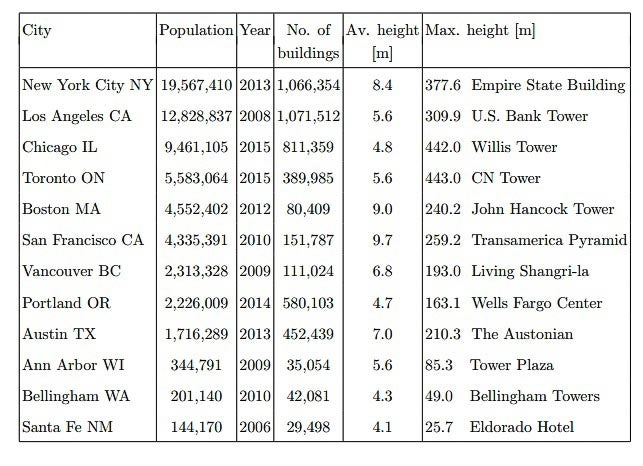In many modern cities, carbon emissions are largely the result of efforts to heat, cool, and power buildings. In New York City, for instance, two-thirds of all energy used is used on just those three things.
Though researchers have spent considerable time quantifying how different construction materials and techniques affect the sustainably of buildings, the same work hasn’t been done on a citywide level.
Researchers at the Santa Fe Institute have tried to fill that void with a first-of-its-kind study published last month and recently featured in the MIT Technology Review.
The Santa Fe Institute’s Markus Schlapfer and other researchers took advantage of newly developed technology that’s quickly producing open-sourced data on the size and shape of buildings within large areas.
They looked at nearly 5 million buildings in 12 North American cities, seeking to establish a model that could predict how buildings will change as cities grow and the consequences those buildings would have on the environment.
They found that as cities grow, their buildings get taller, which gives them the potential to become more energy efficient. But buildings reach an energy-efficiency tipping point as they become taller and skinnier.
One finding is straightforward and aligns with expectations: as cities get bigger, their buildings get taller. And in all the cities studied, buildings get reliably shorter as you move farther from the city center.
But then, the researchers do something interesting: they explain why that common sense expectation is actually true and build a model that sheds light on the expectation that buildings will get taller in a city center as the city grows.
As a city gets bigger, land becomes more valuable – and that happens at a rate that exceeds increases in income, the research shows. Given this trend, cities can either make the space people live in ever-smaller – which is a feature of most cities but can’t be sustained endlessly without resulting in slums – or allow taller buildings.
As this plays out, buildings in cities also become more energy efficient, though only up to a point.
Bigger buildings are more energy efficient because they have a smaller surface area-to-volume ratio than one-story buildings. But the shapes of buildings matter too.
When buildings become more needle-like and less cube-like – think New York City – energy efficiency turns downward again, in part because of the growing amount of space that needs to be devoted to elevators, stairwells and other basic infrastructure, as opposed to living areas.
As a result, cities tend to see their average building types move from flatter structures and toward more cube-like buildings (New York City and Boston were exceptions).
“These results offer a quantitative baseline to predict the change in urban geometry as cities grow in population and wealth,” the researchers wrote.
“This will be especially important in fast developing cities and may also find applications to shrinking urban areas, where such changes in urban form may happen in reverse.”
The researchers emphasize that the breadth and availability of data on building sizes and shapes is sure to grow, leaving room to explore more cities and in different economies and cultures to look for similar relationships.

